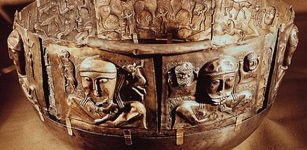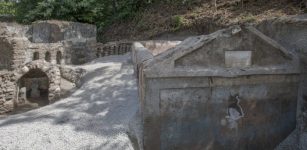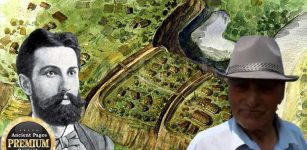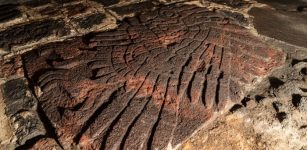Keshwa Chaca – Last Suspension Rope Bridge Of Inca People
A. Sutherland - AncientPages.com - Hanging rope bridges (or the so-called suspension rope bridges) were built by the Inca over canyons, rivers, and ravines. They linked the Inca Empire, providing access to even the most inaccessible region.
Inca suspension rope bridge - Credit: Adobe Stock - Danita Delimont
Five centuries ago, the Andes were filled with hanging bridges. It is believed there were as many as two hundred of them. Also, in Peru – due to the country’s difficult geography, many places were joined by suspension bridges made of vegetable fiber.
The so-called “suspension rope bridges” or “hanging bridges” were important to the Inca’s road infrastructure. They were needed for trade, communication, development, and dominance over the region.
Today, only one suspension rope bridge is left, known as “Keshwa Chaca” (or Q´eswachaka). The Inca have an old tradition of renovating this bridge. Each year, several Cusco families (about a thousand people from different communities ) meet at the bridge's location and prepare a new structure during four days of hard work.
The bridge is located in the department of Cusco, over the Apurímac River, at 3,700 m above sea level.
The “Keshwa Chaca” bridge has been there for 500 years, and the tradition of renewing it has been continued from generation to generation. This bridge owes its existence to the involvement of the local population, which rebuilt it in June each year according to techniques that the Inca ancestors used.
What Keshwa-Chaca Is Made Of?
The Inca suspension rope bridge is created of four parallel ropes (each of them consists of three intertwined cords), on which small twigs are arranged diagonally. Two additionally suspended ropes (they are much thinner) form a handrail. They are connected to the bridge by a system of vertical ropes arranged close to each other, forming balustrade-like support for safety while traversing the bridge.
The whole structure is fastened to stone platforms (abutments) on both sides of the ravine.
Reconstruction Of Keshwa Chaca Takes Three Days
On the first day, people of the communities go out and search for a solid straw of vegetal fiber (in Quechua, it is called “Ichu”). Such fibers were and are today used for the construction of the last hanging rope bridge.
Keshwa Chaca - Suspension Rope Bridge. Credit: Adobe Stock - Danita Delimont
Once the required amount of Ichu has been collected, women weave the straw to form strong ropes, and when they are ready, men begin their job because they are responsible for joining the rope from end to end and then braiding it.
During the second day, the structure of the old bridge is disarmed and removed along with the stone nails that sustain the bridge. Then, the four new ropes that are the base of the structure of the new bridge are placed.
On the third day, the villagers work with assembling the handrails and the bridge's surface. The fourth day is the time of celebration of the reconstruction of the bridge. According to the ancient 500 hundred years old custom, the Inca people listen to their traditional music and perform indigenous dances.
Over time, many bridges were damaged or totally destroyed due to weather conditions (they are constructed at very high altitudes - Keshwa Chaca is 3,700 m above sea level), and the strength of the used material is also low.
However, despite the apparently low strength of the materials used in their construction, the Inca’s Keshwa Chaca is able to maintain the weight of 56 people.
Updated on October 14, 2023
Written by – A. Sutherland - AncientPages.com Senior Staff Writer
Copyright © AncientPages.com All rights reserved. This material may not be published, broadcast, rewritten or redistributed in whole or part without the express written permission of AncientPages.com
Expand for referencesMore From Ancient Pages
-
 Unusual Relic That Mysteriously Disappeared From The Vatican
Ancient Mysteries | Nov 8, 2018
Unusual Relic That Mysteriously Disappeared From The Vatican
Ancient Mysteries | Nov 8, 2018 -
 Skull From Broken Hill, Zambia Is Relatively Young – New Analysis Shows
Fossils | Apr 2, 2020
Skull From Broken Hill, Zambia Is Relatively Young – New Analysis Shows
Fossils | Apr 2, 2020 -
 Corded Ware Culture: Skillful Female Artisans Produced Extremely Innovative Pottery 5,000 Years Ago
Archaeology | Mar 30, 2018
Corded Ware Culture: Skillful Female Artisans Produced Extremely Innovative Pottery 5,000 Years Ago
Archaeology | Mar 30, 2018 -
 Odd Ancient Dwellings Of The Snake People – Clues From Biblical Lands – Part 2
Ancient Mysteries | Sep 10, 2020
Odd Ancient Dwellings Of The Snake People – Clues From Biblical Lands – Part 2
Ancient Mysteries | Sep 10, 2020 -
 Bizarre Ancient Lie Detector – The Mouth Of Truth – Bocca della Verità
Artifacts | Dec 12, 2015
Bizarre Ancient Lie Detector – The Mouth Of Truth – Bocca della Verità
Artifacts | Dec 12, 2015 -
 Remarkable Discovery Of Ancient Drilled Bear Teeth In Kansas – How Did They End Up On The Great Plains?
Archaeology | Mar 25, 2022
Remarkable Discovery Of Ancient Drilled Bear Teeth In Kansas – How Did They End Up On The Great Plains?
Archaeology | Mar 25, 2022 -
 Gundestrup Cauldron: Great Gilded Silver Vessel Decorated With Scenes Derived From Celtic Mythology
Artifacts | May 30, 2016
Gundestrup Cauldron: Great Gilded Silver Vessel Decorated With Scenes Derived From Celtic Mythology
Artifacts | May 30, 2016 -
 Unusual And Well-Preserved Skeleton Discovered In Ancient Pompeii Sheds New Light On The Cultural Life Of The City
Archaeology | Aug 18, 2021
Unusual And Well-Preserved Skeleton Discovered In Ancient Pompeii Sheds New Light On The Cultural Life Of The City
Archaeology | Aug 18, 2021 -
 Genghis Khan Has 16 Million Relatives – You Could Be One Of Them
Ancient History Facts | Feb 3, 2018
Genghis Khan Has 16 Million Relatives – You Could Be One Of Them
Ancient History Facts | Feb 3, 2018 -
 Simon Magus ‘The Magician’ Who Faked Death And Resurrection
Featured Stories | Feb 17, 2022
Simon Magus ‘The Magician’ Who Faked Death And Resurrection
Featured Stories | Feb 17, 2022 -
 66 Diorite Statues Of Lion-Headed Goddess Sekhmet Discovered In Luxor, Egypt
Archaeology | Mar 9, 2017
66 Diorite Statues Of Lion-Headed Goddess Sekhmet Discovered In Luxor, Egypt
Archaeology | Mar 9, 2017 -
 ‘Our Way Model’ Reveals How First Anatomically Modern Humans Populated Europe
Human Beginnings | Oct 7, 2024
‘Our Way Model’ Reveals How First Anatomically Modern Humans Populated Europe
Human Beginnings | Oct 7, 2024 -
 Number ‘Seven’: Mystical Number Of The Universe And One Of The Most Sacred Numbers
Ancient Symbols | Feb 14, 2017
Number ‘Seven’: Mystical Number Of The Universe And One Of The Most Sacred Numbers
Ancient Symbols | Feb 14, 2017 -
 Finds From Archaeological Dig Were Deliberately Hidden From The Public, Says Man Who Participated In The Excavations
Featured Stories | Dec 3, 2024
Finds From Archaeological Dig Were Deliberately Hidden From The Public, Says Man Who Participated In The Excavations
Featured Stories | Dec 3, 2024 -
 Ancient DNA Reveals Missing Link In The History Of Indo-European Languages
Linguistic Discoveries | Feb 5, 2025
Ancient DNA Reveals Missing Link In The History Of Indo-European Languages
Linguistic Discoveries | Feb 5, 2025 -
 Huge Golden Eagle Relief Made By The Aztecs Discovered At Tenochtitlan
Archaeology | Feb 3, 2021
Huge Golden Eagle Relief Made By The Aztecs Discovered At Tenochtitlan
Archaeology | Feb 3, 2021 -
 Dzibilchaltún: One Of The Most Ancient Mayan Centers In Northwest Yucatan, Mexico
Civilizations | Feb 2, 2016
Dzibilchaltún: One Of The Most Ancient Mayan Centers In Northwest Yucatan, Mexico
Civilizations | Feb 2, 2016 -
 Unique And Priceless Large Roman Sculptures Found At Carlisle Cricket Club
Archaeology | May 25, 2023
Unique And Priceless Large Roman Sculptures Found At Carlisle Cricket Club
Archaeology | May 25, 2023 -
 Mystery Of The Amazing 2,500-Year-Old Underwater Rochelongue Treasure
Featured Stories | Jul 7, 2023
Mystery Of The Amazing 2,500-Year-Old Underwater Rochelongue Treasure
Featured Stories | Jul 7, 2023 -
 Tomb Of Celtic Prince Has Been Unearthed In France
Archaeology | Mar 5, 2015
Tomb Of Celtic Prince Has Been Unearthed In France
Archaeology | Mar 5, 2015


